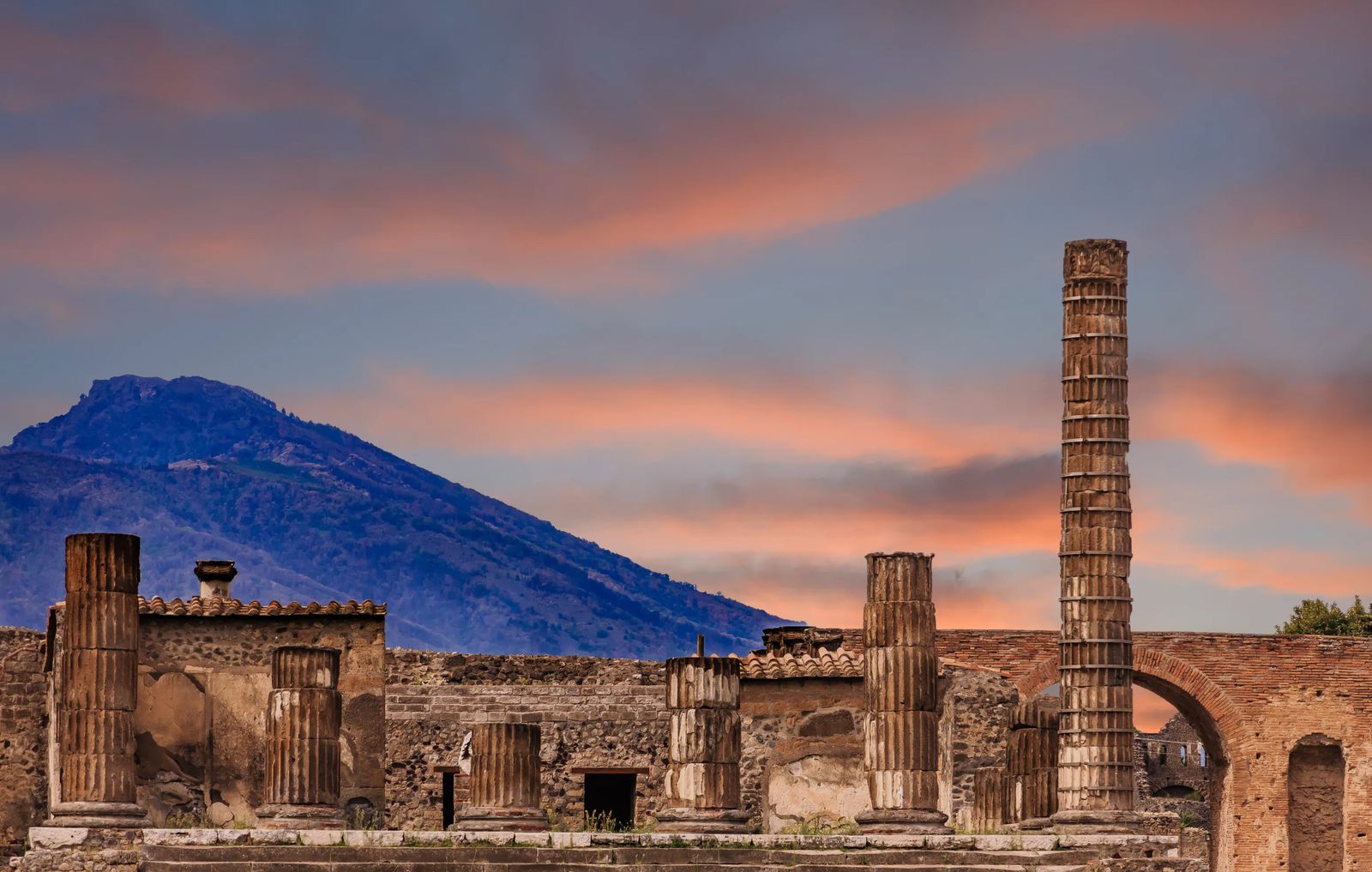
The Ultimate Guide to Pompeii
Pompeii has always held a deep fascination for me. I have been here twice now because the first time we did a self-tour, and I didn't end up noticing half of the things that I learned when taking a guided tour. So after having been there twice now, I put together the Ultimate Guide to Pompeii.
Why was Pompeii important?
After learning more about this place, you walk through its streets and can feel the amazing history, wonder at the extremely detailed and well-preserved ruins, and sense of the palpable weight of the many deaths that occurred there. Pompeii was the city used as a retreat for high ranking generals, nobles, and dignitaries. It was also a major town along the trade route to Rome because of its proximity to the Ocean. Set below the famous, volcanic Mount Vesuvius, around 5 miles away, it was a place of gladiator games, theater, food, trade markets, prostitution, homosexuality, romance, and slavery, and it was all buried under 20 feet of ash from Vesuvius. Pompeii was excavated in the 1700's and because it was buried in ash from the eruption of Mt. Vesuvius, the contents and people of the city were quite well-preserved. Over the years, the streets have become worn from the thousands of tourists visiting this magnificent historical city. That massive foot traffic has started to take its toll on what was once well-preserved. Make sure to see this before it is destroyed by time and tourists.
Traveler tip: If you are booking a guide, make sure that the way they communicate in a large group is with either a microphone or personalized earpieces so you can hear them. Pompeii can become very crowded with lots of different guides speaking a variety of languages, and it gets very hard to hear. It's even more difficult when you are all gathered around looking at the same thing, so make sure you pick a guide or tour that accommodates this, as well as provides an early morning departure time. This way, you can avoid the majority of the crowds from the cruise ships and buses.
The Streets of Pompeii
Our cute, curly-haired Italian guide led us through the streets and pointed out that the stones beneath our feet are made from rocks from Mt. Vesuvius. The stones are approximately 30 cm from the base of the street, and there are elevated sidewalks and stepping stones at the major crossings. These stepping stones were actually a way to avoid the sewage and drainage that was so often running in the streets. They also have a break between stepping stones to allow carriages to pass through (quite ingenious.) In some streets, you can actually still see the crevices where the carriages seemed to pass the most. It's quite fascinating to think that you can actually witness the marks of history in the streets of Pompeii. If you wander in the streets, you will likely notice how straight the roads seem to be. This is quite a feat for an ancient society to be so sophisticated in their grid-like roads and drainage systems. The majority of all roads in Rome and Italy come from the Roman period, where these roads were typically placed by the Roman legion along military and trade routes. They had massive forces and were out to conquer the world or as much of it as they could. A typical invading party would consist of 20,000 legionnaires, 10,000 cavalry, 15,000 auxiliaries, 6,000 support personnel, and 15,000 animals. I would hate to be at the end of that train if the roads weren't precisely engineered.
Road Construction
So how did the Romans construct these roads without all of the technology we possess today? To construct these straight and precise roads, they used a Groma (see photo). If there was a direction change, then a high point was utilized to indicate the change of the direction. A plow loosened the ground, workers dug the trenches on the sides for the slight slope for drainage, the bed was trampled down and then the stone laid on top. This is how these roads were built so incredibly straight. I'm not typically interested in the particulars of construction of roads, but I found this so fascinating for some reason. The anatomy of their roads is incredibly modern! So after learning about all these roads, you turn a corner and see a crooked road and it just throws off your feng shui. The brothels and prostitutes were said to live on these roads and were frequented by all. A customer would enter the brothel where photos were painted on the walls of the different talents the prostitutes in that particular establishment could perform. The customer would then point to a photo and was taken the corresponding room. Erotic murals were said to be painted within these rooms. (No photo included as most are distasteful and I do not wish to offend my readers.)
Pompeii Markets
We wandered down more streets and found this little gem where they bartered and traded food and different products. I hadn't realized that Pompeii was actually situated along a major Roman trade route because of its proximity to the ocean. You can see the loaves of bread and fish depicted in the photo on the right, and on the left, various other outlines of different trades and services offered within this market. What was amazing to me was how detailed the murals were and the amount of color that went into them (as artificial coloring was not yet available to this ancient society). If they are this colorful now after so many years, can you imagine how vibrant it must have been during the time of the Roman empire?
Our guide then told us about the word siesta. In modern times, it's considered to be a luxury, but in ancient times it was deemed a necessity. Siestas were typically taken during the hottest parts of the day to avoid the oppressive heat. The word siesta comes from the Latin word 'hora sexta' meaning "the 6th hour of the day," where there was a dedicated time to grab some fresh sardines and bread on the street, then take a nap before returning to the order of the day.
The Temple of Apollo
After our short siesta history lesson, we visited the temple of Apollo. It boasted magnificent preservation of columns, statues, and mosaics, where you could truly imagine it as a place of reflection and religious pursuits of the time. This particular temple dates clear back to the 6th century; even back to the Samnite period. It has both Roman and Greco-style influences throughout. The perimeter is surrounded by 48 columns that were originally 2 stories high, and the inner 'cella' (center) houses a sacrificial altar with Apollo shooting arrows at Diana (the original statues are housed in the National Archeological Museum in Naples). There is also a sundial or meridian that was found to the left of the stairway to the temple. Interestingly enough, this temple is one of the oldest in the city and Apollo was, in fact, one of the main divinities of early Pompeii.
Roman Bath's in the Ultimate Guide to Pompeii
Prior to entering a temple, patrons would typically bathe themselves; so we stopped at a magnificent bath house where it was so well preserved I nearly giggled. Why would I giggle? Because it was like I was literally walking into a REAL bathhouse where you could see the intricate and magnificent Roman statues holding up the ceiling, the hollow tubes that were inside the walls to warm the different areas, the elevated floor where steam was pushed through so you weren't walking on cold floor, a huge basin where you could go and cool down if you were too hot, and the wonderful ceilings that are RARELY EVER seen in a place as old as this! I couldn't believe it!
My Grandma and I have always been fascinated by Roman History. We watch Gladiator together all the time. This experience felt like I was seeing first-hand how Maximus would have bathed, and it just made me kind of giggle knowing my imagination was running away with me; but how could it NOT in a place such as THIS?!
We left the bathhouse and took a drink from the ancient aqueducts that run throughout the city. They are still widely used today throughout both Pompeii and Italy, and the water often flows from the mouths of Lions. In addition to the very modern plumbing throughout the city, most houses also had indoor plumbing! Aqueducts would bring fresh water into the home and either pass through via a small trough-like stream or be used and stored in large cisterns or water-collecting basins within the home itself. I pondered the complexity of their society as well as the fact that they were so well supplied with more modern conveniences. I never imagined an 'ancient' society such as this.
The Tragedy of Pompeii
The next leg of my tour is where things got a little sobering and dark for me. I work in the medical field, so I have seen dead bodies. I have watched first-hand as life slipped away from someone who lost the battle to infection, cancer, etc. This was disturbing for me though, to see the encasement of the bodies that had died during the eruption of Mt. Vesuvius so long ago.
Originally, the bodies were buried in the ash where they eventually decayed, leaving the shells surrounding the area where they had once been. A scientist then used a form of ultrasound/radio-frequency to locate these cavities and injected plaster into them to preserve the area, allowing for their excavation. The result is a macabre witness to the magnitude of the volcanic eruption, the fear that must have consumed the inhabitants of Pompeii, and the horrific ways in which they died. Their terror is visible in their body language and in their faces. These encasements or historical cavities were found both within the town and clear down by the ocean as if the residents were trying to take to the sea to escape the volcano's wrath. Mothers cradling their babies, pregnant women, lovers holding each other in bed; it's sobering and broke my heart a little to see all of this destruction. So many were found in their beds that it is assumed the eruption happened late at night, and likely took the whole town by surprise.
The last thing we looked at while in Pompeii was the names of different houses and streets. The graffiti on the streets was actually announcements and advertisements. Most of the streets are classified and named by modern street signs to help tourists and guides find their way. Many scholars believe that the streets were likely named by nobles who often spoke Greek. Three languages were spoken in Pompeii - Latin (of course), Oscan (the language of the people in the area), and Greek (still spoken throughout Magna Grecia as well as the language of sailors throughout the Roman territories). They know these were the core languages based on the graffiti that was found on the street corners and walls.
There was one particular house that had a title over the door. I remember our guide telling us that gladiators and slaves didn't have names, only a particular nickname under the master they belonged to or were owned by. Under some circumstances, if a Gladiator was quite fierce or famous, they were given their own particular name with a suffix in Roman that indicated their rise from slavery. If I'm not mistaken, I believe this sign adorning the top of the house was one of these examples.
In the end, Pompeii was a sobering and fascinating place with detailed and magnificent preservation. I think all could and should learn from such an emotionally evoking environment. So if you get a chance to visit, I hope the information provided here helps you realize that you are literally standing amongst the best-preserved history of the Roman Empire, and likely one of the most tragic moments in its history.
Traveler Tip: Where to stay and how to get there: Stay in Sorrento because it is a 30 minute train ride to Pompeii, instead of a half day trip from Rome (3.5 hours each way to travel if coming from Rome). Sorrento is a coastal town that is very tourist friendly and most people speak English, while Naples is a quieter town and not so overrun with tourists (just my kind of town). Other nearby towns that are worth a visit include: Capria, Positano, Amalfi, Herculeneum, Naples, Paestum.
Recipe of Ancient Pompeii:
Ius Diabotanon in Pisce Frixo (Fish in Herb Sauces)
4 Whitefish
3 tsp cumin
3 tsp coriander seed
3 tsp oregano
3 tsp rue
1 garlic
1 carrot
Honey to taste
Oil and Vinegar to Taste
Defritum (Grape juice to taste)
Liquamen (Salt)
Black pepper to taste
Instructions: Prepare, clean, turn in flour, and salt and fry the fish. Finely crush pepper, cumin, coriander seed, oregano, rue, and garlic; moisten with vinegar, a carrot, honey, oil, Defritum, and Liquamen. Pour in the saucepan, place on fire. When simmering, pour over the fried fish, sprinkle with pepper, and serve. (Read here for more recipes like this.)


Welcome to Culture Trekking!
My name is Janiel, a leader in the travel industry with over 20+ years of experience with international travel. I specialize in solo female travel, cultural connections, sustainable adventures, food and history to help make your travel experiences fun, meaningful, and delicious. My experience in travel, and my personal story have allowed me to get published in Fodor's Travel, Atlas Obscura, Metro.co.uk, Trip Advisor, and multiple Podcast interviews. You can find me on pretty much every social media channel YouTube, Instagram, Twitter, Facebook, Pinterest, TikTok. To read more about me and my story click here. If you are a brand and would like to work with me, click here.


